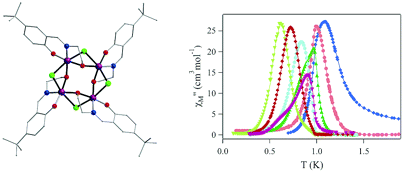Abstract of Publication No. 466
 Colette Boskovic, Roland Bircher, Philip L. W. Tregenna-Piggott, Hans U. Güdel, Carley Paulsen, Wolfgang Wernsdorfer,
Anne-Laure Barra, Eugene Khatsko, Antonia Neels and Helen Stoeckli-Evans
Colette Boskovic, Roland Bircher, Philip L. W. Tregenna-Piggott, Hans U. Güdel, Carley Paulsen, Wolfgang Wernsdorfer,
Anne-Laure Barra, Eugene Khatsko, Antonia Neels and Helen Stoeckli-Evans
Ferromagnetic and Antiferromagnetic Intermolecular Interactions in a New Family
of Mn4 Complexes with an Energy Barrier to Magnetization Reversal
J. Am. Chem. Soc. 125, 14046-14058 (2003)
![]()
![]()
![]()
![]()
![]()
![]()
![]()
Abstract:
A new family of tetranuclear Mn complexes
[Mn4X4L4] (H2L =
salicylidene-2-ethanolamine; X = Cl (1) or Br (2)) and
[Mn4Cl4(L')4] (H2L' =
4-tert-butyl-salicylidene-2-ethanolamine, (3)) has been
synthesized and studied. Complexes 1-3 possess a square-shaped
core with ferromagnetic exchange interactions between the four MnIII
centers resulting in an S = 8 spin ground state. Magnetochemical studies
and high-frequency EPR spectroscopy reveal an axial magnetoanisotropy with
D values in the range -0.10 to -0.20 cm–1 for
complexes 2 and 3 and for differently solvated forms of 1.
As a result, these species possess an anisotropy-induced energy barrier to
magnetization reversal and display slow relaxation of the magnetization, which
is observed as hysteresis for 1 and 3 and frequency-dependent
peaks in out-of-phase AC susceptibility measurements for 3. The effective
energy barrier was determined to be 7.7 and 7.9 K for 1 and 3,
respectively, and evidence for quantum tunneling of the magnetization was
observed. Detailed magnetochemical studies, including measurements at ultralow
temperatures, have revealed that complexes 1 and 2 possess
solvation-dependent antiferromagnetic intermolecular interactions. Complex
3 displays ferromagnetic intermolecular interactions and approaches a
ferromagnetic phase transition with a critical temperature of ~1 K, which is
coincident with the onset of slow relaxation of the magnetization due to the
molecular anisotropy barrier to magnetization reversal. It was found that the
intermolecular interactions have a significant effect on the manifestation of
slow relaxation of the magnetization, and thereby, these complexes represent a
new family of "exchange-biased single-molecule magnets", where the exchange bias
is controlled by chemical and structural modifications.